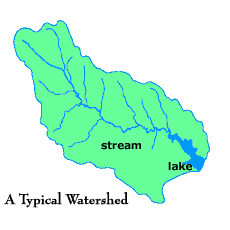Protecting Surface Water Quality
This section discusses the importance of protecting the water resources on your property - natural or constructed. Topics include Watersheds and Water Quality, Wetlands and Riparian Areas.

Protecting Surface Water Quality
Protecting the water resources on your property, whether natural or constructed, should be one of your highest priorities. Well-managed streams, ponds and wetlands add beauty and diversity to the landscape and enhance the value of the property. In addition, we all have a responsibility to use our water resources wisely and to protect them from contamination.
 Watersheds and Water Quality
Watersheds and Water Quality
A watershed is an area of land from which all runoff drains to a common outlet such as a stream, river, lake or wetland. Land use within a watershed influences both the quantity and quality of runoff. Runoff carries sediment, plant nutrients, oil, antifreeze, pesticides and other pollutants directly into surface waters. Because most of this pollution comes from many dispersed sources throughout a watershed, it is referred to as nonpoint source pollution.
Everyone lives and works in a watershed and has an impact on water quality. Therefore, a conscious, cooperative effort by everyone in the watershed is the key to reducing the impact of nonpoint source pollution.
Wetlands
Wetlands are environmentally important areas on the landscape where the water table is usually at or near the surface, or the land is covered by shallow water. They generally occur in conjunction with aquatic systems such as streams or lakes, but also can occur in small depressional areas on uplands.
Wetlands play a significant role in protecting water quality by trapping sediment, storing nutrients and removing many other types of contaminants from surface water. Wetlands also provide habitat for a wide variety of plants and animals.
It is illegal to fill or drain a wetland without first obtaining a permit from the U.S. Army Corps of Engineers. To determine whether or not you have a wetland area, contact your local office of the Natural Resources Conservation Service.
Riparian Areas
Riparian areas are unique ecosystems located along the banks of streams, rivers, lakes and wetlands. Because they occur at the interface between upland areas and bodies of water, the importance of riparian zones far exceeds their minor proportion of the land base. Healthy riparian vegetation stabilizes stream banks, traps sediment eroded from upland areas and can remove plant nutrients and other contaminants from runoff before they reach the stream. Riparian areas are also valuable as a source of food, water and cover for wildlife.
Source: Adapted for Lancaster County, Nebraska from A Place in the Country: The Acreage Owner's Guide (EC97-2506C).
What can YOU do?
- Control runoff and soil erosion on your property.
- Use fertilizers and pesticides sparingly and according to label directions.
- Dispose of used oil, antifreeze, paints and other household chemicals properly.
- Properly maintain septic systems and lagoons.
- Protect wetlands and riparian areas.
Need Additional Information? Visit What you need to know as a Nebraska landowner
More Acreage Resources & Small Farm Resources